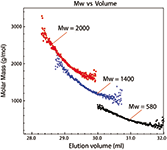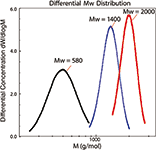Low Molecular Weight Polystyrene Characterized by SEC-MALS
The Application Notebook
The fundamental physical principles of light scattering employed in a DAWN® or miniDAWN® multi-angle light scattering (MALS) instrument enable low molecular weight materials to be characterized effectively without the need for column calibration or reference standards. Thanks to their advanced electro-optical design, samples with molecular weights below 2000 Da can be measured easily and with remarkable precision.
The DAWN's multi-angle detection system means that accurate molecular weights can be determined-even from samples that produce low signal levels, whether they are ultra-low-concentration high-Mw molecules or higher concentrations of low-Mw molecules. Since each and every detector contributes to the molecular weight calculation, the result is more sensitive and precise than that produced by any single or dual angle instrument. This is particularly important for low molecular weights where the signal may be only slightly above the background produced by scattering from the solvent.

Figure 1 shows the SEC chromatogram, overlaid with molecular weight values derived from MALS measurements, for three narrow polystyrene samples nominally of 580, 1400, and 2000 g/mol. Corresponding masses injected were 7.1, 2.9, and 2.2 mg, respectively. ASTRA® software determined the following weight-average molecular weights, all very close to the stated Mw values.

Although the misconception lingers that light scattering is ineffective at low molecular weights, this experiment demonstrates that it can be used to produce robust and accurate results.
Figure 2 shows the results of ASTRA's differential molecular weight distribution analysis of the three samples. While MALS is widely prescribed in the characterization of molecular weights from 104 to 109 g/mol, it is not widely recognized that this technique is effective for smaller molecules too. These data clearly indicate that MALS has no difficulty analyzing molecules in the range of hundreds to thousands of g/mol. In fact, reliable measurements have been demonstrated on other samples down to 200 Da!

For light scattering, the lower molecular weight detection is limited only by the concentration of the sample being prepared, as opposed to any inherent measurement shortcomings. This application note confirms that the lower limits can be extended into the range of only a few hundred daltons-with no column calibration, reference standards, or other assumptions required.

Wyatt Technology
6330 Hollister Avenue, Santa Barbara, CA 93117
tel. +1 (805) 681-9009
Website: www.wyatt.com


.png&w=3840&q=75)

.png&w=3840&q=75)



.png&w=3840&q=75)



.png&w=3840&q=75)











